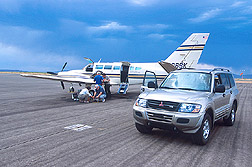| 
Click image for caption and other photo
information.
Read the
magazine
story to find out more.
|
Predicting
Flooding Earlier By Mapping Soil Moisture
By Don Comis
August 24, 2001 Within 10 years, daily newscasts may
include weather reports based on soil moisture maps that can predict floods in
their infancy, along with droughts, tornadoes and hurricanes.
On a prototype of just such a map, signs of the April 12 Mississippi flood
first appeared on March 29 as a small, blue patch of oversaturated soil in the
Dakotas. Knowing the terrain and water systems, it would have been easy to
predict that the water would end up in Mississippi.
Agricultural Research Service
hydrologist Tom Jackson prepared the map after the flood, using satellite data.
The actual maps will come from sensors aboard a pair of U.S.-European
long-range weather-forecasting satellites proposed for launch in 2008. A
similar sensor will also be mounted on NASA's soon-to-be-launched Aqua
satellite. Each dish measures soil moisture by capturing the soil's natural
microwave emissions.
The sensors are part of a Soil-Moisture Observing System envisioned by
Jackson, who is with ARS' Hydrology and
Remote Sensing Laboratory in Beltsville, Md. The
Henry A. Wallace Beltsville Agricultural
Research Center has land adjacent to NASA's Goddard Space Flight Center in Greenbelt,
Md.
Together with NASA and other agencies, Jackson and colleagues tested Aqua's
sensor in airplane and satellite flyover campaigns in Arizona and Oklahoma and
will soon test it in Iowa. From this research, techniques have emerged that
will be used to translate Aqua's data into maps.
Jackson is calibrating the sensor with ground data from ARS soil moisture
instruments in Arizona, Georgia, Oklahoma and Idaho. He is also using data from
40 USDA Natural Resources Conservation
Service ground-monitoring stations across the country. The NRCS data,
available on the World Wide Web at http://www.wcc.nrcs.usda.gov/scan,
can be read one hour after being collected, 24 hours a day.
For more details, see the August issue of Agricultural Research magazine.
ARS is the U.S. Department of
Agriculture's chief scientific research agency.
|